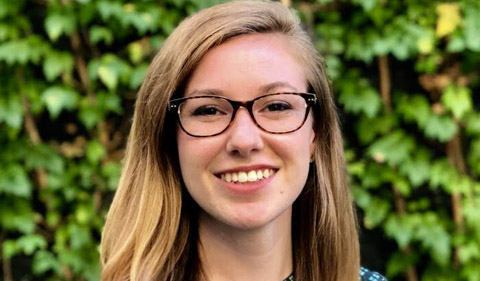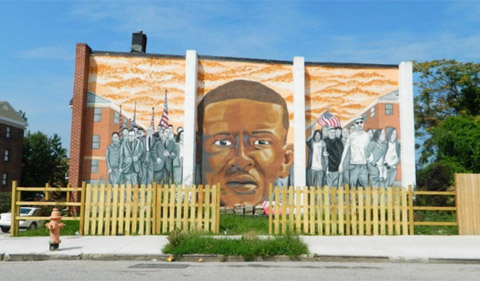Editor’s Note: The Happy Beginnings series features recent College of Arts & Sciences graduates who are getting started in careers, graduate school, and service.
By George Shea
Ohio University alum Meredith Stone ’17MA analyzed the breathtaking murals in Baltimore, seeing not just images that transcend political and social boundaries but also a catalyst for change.
Stone’s paper exploring race and place— “Street Art in Baltimore: A Catalyst for Change“—was accepted in the journal Focus on Geography. It is co-authored by Dr. Geoffrey Buckley, Professor of Geography at OHIO.
Stone now works at the American Association of Geographers.
In the article, Stone explores how the powerful expression of street art can be viewed as a key part of influencing social change. Street art is a visual art form created normally without approval. This art is unlike any traditional museum as it affects viewers in both beautiful and provocative means. It is usually a comment on the political and social climate of the specific area. In Baltimore, Md., the city’s history makes it a significant canvas for street art.
“I was first interested in street art when I visited Paris the summer before my senior year of college. Art is very prominent in French culture, but I did not expect to see so much art out in public that wasn’t necessarily sanctioned by the city or a museum and would not fit into the categories of graffiti or tagging,” Stone says of her thesis project for the M.A. in Geography.
After the death of Freddie Gray, a 25-year-old African American resident, the city was thrust in a period of unrest that resulted in many protests. Yet a number of people in Baltimore responded in a different way, one that would change the way the streets look throughout the city.
Throughout her article, Stone explores the inequality, segregation, and poverty that exists because of slavery, Jim Crow, redlining, and housing discrimination. She then interviews six artists and educators to discover how street art became a catalyst for change. Stone also photographed all the murals featured in her paper through multiple visits to Baltimore.
“Artists think of place and space in a very similar way to geographers wherein context is always very important, and it matters which art ‘lives,’ where, why, and when,” She adds. “Street art in particular often makes a very specific activist statement. I think this is very important in America today.”
In Baltimore today, there are at least 165 murals in the city that give voice to those who have not been heard. The street artists who compose these murals are not recognized as graffiti artists, or rather “writers” for that matter. These artists spend considerable time on their pieces, some the work featuring murals commemorating Freddie Gray, the Black Lives Matter Movement, and the Civil Rights Movement.
The piece “The Thoughts in my Head” by Megan Lewis stands out significantly to Stone. This piece is only a few blocks away from the Freddie Gray memorial mural and beautifully portrays a woman with the world in her hand and civil protests on her mind.
“I think it is a great representation of the folks I met in Baltimore while conducting my research, and I think it speaks very well to the #blacklivesmatter movement in Baltimore,” Stone says. “It captures the intensity of activism while also giving an air of positivity and hope.”
Stone obtained the grant to complete her research with help from adviser Dr. Geoff Buckley, Professor of Geography. She worked as his research assistant helping with the Baltimore Ecosystem Study Long Term Ecological Research project, which was funded by the National Science Foundation. This program studies the distribution of urban parks and street trees across the urban landscape while focusing on the intersection of social and ecological systems in Baltimore.
“I was thrilled to be involved,” she says. “Dr. Geoff Buckley encouraged me to investigate Baltimore because of my interest in studying race and place in America. I think it is fascinating the way art and #blacklivesmatter came together in Baltimore, a city that has a complicated past and present with race while simultaneously being a hub for the arts.
Stone has always had an interest in geography from a young age. She says geography is interdisciplinary and allows for an exploration of many topics all within the context of space and place. She completed her undergraduate degree at the University of Mary Washington in Fredericksburg, Va., studying geography. There, she also was a research assistant on an NSF project investigating ways in which slavery was presented at plantation museums across the U.S. South.
“You would never guess, but Mary Washington’s geography program has a strong relationship with OHIO’s,” she says. “I got advice from my fellow Mary Washington alumni that OHIO was a great place to be for my interests, and they were right!”
Working at the American Association of Geographers
Stone now works at the American Association of Geographers as the Annual Meeting and Outreach Associate. She actively supports geographers by helping to plan the AAG annual meeting through a conference of around 9,000 attendees.
“I love that I get to interact with so many geographers,” she says.
She wants to thank the entire OHIO Geography Department as they helped her, gave her ideas, and advised her throughout her thesis research. She is thankful for Buckley, Dr. Harold Perkins, and Dr. Amy Lynch, who were her thesis committee members.
“They were all very enthusiastic and encouraging about this project!” Stone says.






















Comments